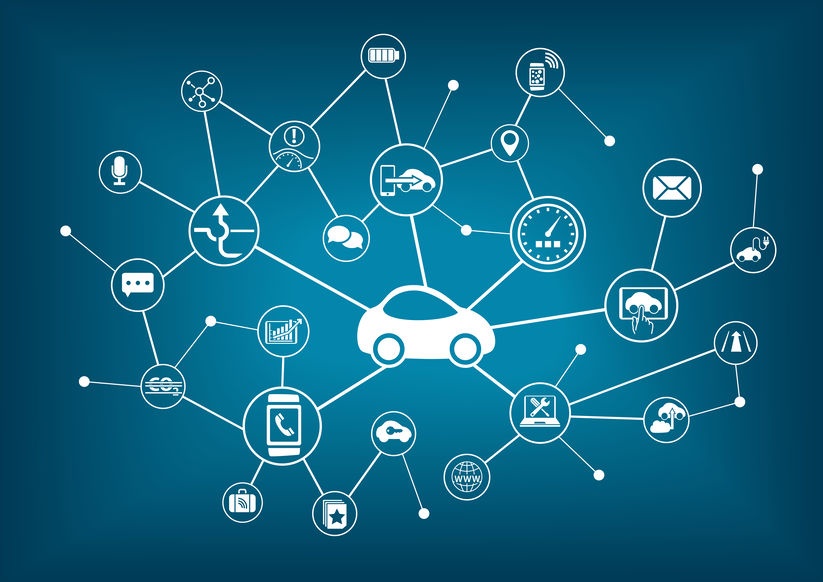What Makes a Smart Car Smart?
Smart cars, in general, are viewed as vehicles incorporating “advanced electronics”[1] or with integrated “connected components.”[2] Either way, the idea is to provide enhanced value to passengers, drivers, ride sharing services and auto manufacturers. When people think of prevalent car trends, four areas often come to mind:
- Autonomous – cars that drive themselves
- Connected – cars that communicate externally
- Electrified – cars that eliminate or reduce reliance on fossil fuels
- Shared – cars optimized for ride sharing or deliveries
The automobile industry talks about these as the four ACES trends, with the cornerstone being connectivity. This communication is typically used for external connections to other vehicles (V2V), infrastructure (V2I) or pedestrians (V2P), collectively referred to as vehicle-to-everything (V2X).
Emerging 5G networks together with smart cities will unlock incredible potential for these V2X connected cars, as well as enabling easy, seamless interactivity of the car to its passengers. This is where Cota will bring the driver and passenger experiences to new levels by providing real wireless power.
While vehicle connectivity doesn’t always garner as much press as autonomous cars and electric vehicles (EVs), the automotive industry and government entities are extremely active in this area. As an example of data driving this connectivity boom, Data Bridge Market Research reported that the “global automotive sensors market accounted to USD $23.0 billion in 2016,” and predicts it will grow at a CAGR of 7.1% from 2017 to 2024.[3]
How will this plethora of automotive sensors receive reliable power and communications within the vehicle -- and to the riders -- in real time? The answer is wireless power.
Wireless Power Enables Vehicle Connectivity Innovation
Traditionally, the many systems in a vehicle worked on their own, without “communicating” with each other. This connectivity and associated analytics are needed to “create a ‘cognitive car’ that can predict vehicle failures before they happen, redirect drivers to less congested routes and help reduce traffic accidents.”[4]
Vehicle sensor interconnectedness can also learn from the driver’s behaviors and preferences to adjust the car’s responses, performance and even create personalized spaces.
Real wireless power like Ossia’s CotaⓇ enables this two-way, real-time communication and control, while providing continuous, automatic power without wires, while in motion, and at a distance.
In fact, passenger cars, commercial trucks, and even mass transportation will soon have the Cota wireless power system built right in, as early as 2021, due to a recently formed joint venture between Ossia and Motherson, a leading manufacturer of components and solutions for top automotive and transportation OEMs.
Connected car is an area where wireless power can really make a difference in optimizing car features, enabling unheard of innovations and creating revolutionary designs.
Wireless Power and Vehicle Connectivity Benefits
Wirelessly powered automotive sensors, switches, actuators, lights, speakers and other devices enable the freedom to place devices in previously unthinkable locations. Some of the wireless power benefits that automotive manufacturers are already exploring or have developed are:
- Creating truly personal spaces using sensors, speakers and switches “floating” in seats and on seat belts
- Unprecedented ability to customize interiors for branding, personalization and convenience
- Predictive analytics to improve vehicle reliability, reduce maintenance and energy usage
- Automatic powering of passengers’ personal devices, key fobs, health monitors, and smartwatches without wires
- Visual sensors that help the car stay in the lane, within a safe distance behind the car in front or alert drivers to obstacles
- Real-time information to alert the driver of road hazards or drowsy driving behaviors
- Reducing emissions by avoiding stop-and-go-traffic
Smart Cars Can Wirelessly Connect with Smart Devices at Home
Smart home devices are not the only Internet of Things (IoT) gear that can increase safety, convenience, comfort and save cost. Smart cars can wirelessly connect with those smart home devices to accomplish tasks like adjusting the house temperature or lights as you leave or arrive, opening the garage as you pull into the driveway, locking the doors as you leave, and a whole lot more than haven’t been imagined yet. Wireless power makes these connections easier than ever to put in place, without having to worry about replacing batteries.
Real wireless power isn’t just about providing wireless, non-line-of-sight energy at the most efficient, cost-effective, environmentally friendly times, it’s also about interconnecting and controlling those sensors, switches, actuators and other devices, which allows previously impossible applications within vehicles, homes, offices, and even between vehicles.
For a truly interconnected world, wireless power delivered with communications and control is a necessity and a groundbreaking enabler.
How Cota Real Wireless Power Works for Connected Cars
Cota is an unmatched, proven wireless power technology that is available for vehicle OEMs to integrate into their products. A 3-time CES Innovation Award Winner in 2016, 2017,2018 and in the running for next year 2019, Ossia’s Cota is:
- Wireless power to multiple devices without wires or relying on charging pads
- Power delivered safely over-the-air at a distance, while in motion
- A two-way communication and control tool that can be securely managed on the cloud
Cota wireless power offers vehicle design studios and manufacturers ways to craft previously unimaginable safety, comfort, and analytics features that are reliably powered, and seamlessly interconnected with other Cota wireless power systems. Learn more about how Cota works using patented technology to deliver power while keeping people safe.
Related Articles on Wireless Power for the Automotive Industry
- The Global Standard for Wireless Power Is Here
- How to Overcome the Biggest Hurdle for Automotive Product Innovation
- Automotive Industry Is Embracing Wireless Power Faster Than Expected
- Your Next Car May Have Real Wireless Power Built Right In!
- Ossia Forms Joint Venture with Motherson Innovations to Bring Real Wireless Power™ to the Automobile
[1] https://www.pcmag.com/encyclopedia/term/51503/smart-car
[2] https://www.enisa.europa.eu/topics/iot-and-smart-infrastructures/smart-transport
[3] https://theanalystfinancial.com/272530/automotive-sensors-market-research-and-forecast-2018-analysis-trend-growth-research-and-drivers-by-2024/
[4] https://phys.org/news/2010-05-smart-car.html#jCp







